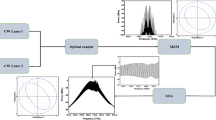Abstract
Transmission of information takes place simultaneously over the same available channel bandwidth in Code Division Multiple Access (CDMA) technique. The spread spectrum (SS) technique is used in CDMA systems for transmission of information by employing spreading codes. A unique spreading code, acts as a signature code, is assigned for each individual user. The signal occupies a bandwidth much larger than the minimum necessary to send the information in SS modulation technique. A synchronized reception with the code at the receiver is applied for dispreading the information before the data recovery. From a long-term, Walsh-Hadamard codes have been employed as spread spectrum codes in CDMA communications due to their ease of generation. Walsh-Hadamard codes are absolutely orthogonal binary user codes which have so many favourite applications in synchronous multicarrier communications. However, the optical application of Walsh-Hadamard codes turns important for optical CDMA to solve the above problem. For this, the designs need the use of nonlinear optics capable of controlling multi-valued signals. To achieve this goal all-optical terahertz optical asymmetric Demultiplexer based design of Walsh-Hadamard codes is explored in this paper.








Similar content being viewed by others
References
Caulfield, H.J., Dolev, S.: Why future supercomputing requires optics. Nat. Photon. 94, 262–263 (2010). doi:10.1038/nphoton
Caulfield, H.J., Dolev, S, Green, W.M.: Optical high-performance computing: introduction to the JOSA A and Applied Optics feature. J. Appl. Opt. A. 48(22), OHPC1–OHPC3 (2009). doi:10.1364/AO.48.0OHPC1
Chattopadhyay, T., Roy, J.N., Chakraborty, A.K.: Polarization encoded alloptical quaternary R-S flip-flop using binary latch. Opt. Commun. 282, 1287–1293 (2009). doi:10.1016/j.optcom.2008.12.022
Eichmann, G., Li, Y., Alfano, R.R.: Optical binary coded ternary arithmetic and logic. Appl. Opt. 25(18), 3113–3121 (1986)
Huang, Y.K., Glesk, I., Shankar, R., Prucnal, P.R.: Simultaneous all-optical 3R regeneration scheme with improved scalability using TOAD. Opt. Express 14(22), 10339–10344 (2006)
Ji, C., Broeke, R.G., Du, Y., Cao, J., Chubun, N., Bjeletich, P., Olsson, F., Lourdudoss, S., Welty, R., Reinhardt, C., Stephan, P.L., Yoo, S.J.B.: Monolithically integrated InP based photonic chip development for O-CDMA systems. IEEE J. Select. Topics Quantum Electron 11, 66–77 (2005)
Jung, Y.J., Lee, S., Park, N.: All-optical 4-bit gray code to binary coded decimal converter, optical components and materials. Proc. SPIE 6890, 68900S (2008)
Li, J., Li, L., Jin, L., Li, C.: All-optical switch and limiter based on nonlinear polarization in Mach-Zehnder interferometer coupled with a polarization maintaining fiberring resonator. Opt. Commun. 260, 318–323 (2006)
Liu, S., Li, C., Wu, J., Liu, Y.: Optoelectronic multiple-valued logic implementation. Opt. Lett. 14(14), 713–715 (1989)
Maity, S.P., Mukherrjee, M.: On optimization of CI/MC-CDMA system. 20th IEEE Personal, pp. 3203–3207. Indoor and Mobile Radio Comm. Symp., Japan (2009)
Popovic, B.M.: Spreading sequences for multicarrier CDMA systems. IEEE Trans. Commun. 47(5), 918–926 (1999)
Reed, G.T., Mashanovich, G., Gardes, F.Y., Thomson, D.J.: Silicon optical modulators. Nat. Photon. 4(8), 518–526 (2010). doi:10.1038/nphoton.2010.179
Roy, J.N., Gayen, D.K.: Integrated all-optical logic and arithmetic operations with the help of TOAD based interferometer device–alternative approach. Appl. Opt. 46(22), 5304–5310 (2007)
Shen, Z.Y., Wu, L.L.: Reconfigurable optical logic unit with a terahertz optical asymmetric demultiplexer and electro-optic switches. Appl. Opt. 47(21), 3737–3742 (2008)
Shvets G. Optical polarsizer/isolator based on a rectangular waveguide with helical grooves. Appl. Phys. Lett. 89(14), 141127 (2006). doi:10.1063/1.2355466
Sokoloff, J.P., Prucnal, P.R., Glesk, I., Kane, M.: A terahertz optical asymmetric demultiplexer (TOAD). IEEE Photon. Techno. Lett. 5(7), 787–789 (1993)
Sokoloff, J.P., Glesk, I., Prucnal, P.R., Boneck, R.K.: Performance of a 50 Gbit/s Optical time domain multiplexed system using a terahertz optical asymmetric demultiplexer. IEEE Photon. Techno. Lett. 6(1), 98–100 (1994)
Taraphdar, C., Chattopadhyay, T., Roy, J.N.: Designing of polarization encoded all-optical ternary multiplexer and demultiplexer. Recent Pat. Signal Process. 1, 143–155 (2011). doi:10.2174/1877612411101020143
Wang, B.C., Baby, V., Tong, W., Xu, L., Friedman, M., Runser, R.J., Glesk, I., Pruncnal, P.R.: A novel fast optical switch based on two cascaded terahertz asymmetric demultiplexers (TOAD). Opt. Express 10(1), 15–23 (2002)
Woods, D., Naughton, T.J.: Photonic neural networks. Nat. Phys. 8, 257–259 (2012). doi:10.1038/nphys2283
Wornell, G.W.: Spread-signature CDMA: efficient multi-user comm-unication in the presence of fading. IEEE Trans. Inform. Theory 41(5), 1418–1438 (1995)
Author information
Authors and Affiliations
Corresponding author
Rights and permissions
About this article
Cite this article
Mandal, A.K. Full-Optical TOAD based Walsh-Hadamard code generation. Opt Quant Electron 49, 290 (2017). https://doi.org/10.1007/s11082-017-1130-4
Received:
Accepted:
Published:
DOI: https://doi.org/10.1007/s11082-017-1130-4




